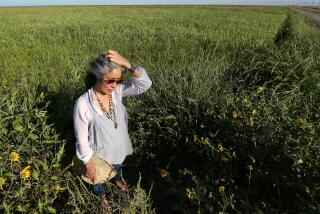Rice: A gift from the gods to earth
- Share via
A Javanese tale of heaven and earth, a goddess and an incestuous love affair describes the creation of a sacred grain. It speaks of hope and faith, the cycles of life. And you thought rice was boring.
“The Art of Rice: Spirit and Sustenance in Asia” is the title of a traveling exhibition of more than 200 objects at the UCLA Fowler Museum of Cultural History that will run Oct. 5 until April 25.
Six years in the making, the exhibition examines the role of rice in Asian cultures. In doing so, says Roy Hamilton, curator of Asian and Pacific Collections, it prompts questions regarding the role of food in all cultures.
“There’s a lesson here for people to think about that somewhat transcends the immediate idea of rice itself,” Hamilton says. “It’s how food and culture can structure who we are, and even how states are organized.”
At the heart of the exhibition is a mystery.
Last year, Hamilton was pondering how to fill a noticeable void in the exhibition. An expert on Indonesia, he wanted to include an architectural representation of the traditional Javanese rice harvest, which involves rituals associated with Dewi Sri, the rice goddess.
It is said that she married her brother/consort, Jaka Sedana, and in doing so was exiled from heaven to earth. Each year, the first rice stalks are clothed in a batik cloth and taken to the farm owner’s house, where a sacred chamber in the back of the house awaits. The stalks represent the divine couple, says Hamilton, and offerings are made.
The sacred area sometimes is represented by a bed, with a frame carved from wood. Hamilton knew of one such bed in Holland, but it would be difficult to procure for the exhibition.
“I was thinking there really wasn’t much chance of getting one when out of the blue I got a phone call from a woman in Silver Lake, and the first thing she said was, ‘I have a wall from an Indonesian house.’ ”
The wooden partition, a representation of the sacred chamber, was 40 feet long and 11 feet high. It’s believed to have been built in the early 1900s in northern Java. Now Hamilton is intrigued by the notion of finding the family that originally owned it.
The piece’s more recent past is more accessible and less mysterious. It was bought through Ebay. The woman donated it to the museum, but because of its size, it was disassembled into 109 pieces for storage. It has been reassembled for the exhibition.
Also included in the exhibition will be a Japanese screen from the Edo period (1603-1868). Because it is so delicate, it will only be displayed for the first six weeks of the exhibition and will be replaced by 18th century Chinese woodblock prints.
There will be Chinese ceramics and bronzes, contemporary paintings, one from the Philippines and two from Korea, religious posters, pop art, political satire from the 19th century, even a puppet show depicting Javanese mythology’s take on the creation of rice, which is regarded as a gift from the gods in many Asian cultures.
The exhibition reflects research by an international group of 24 anthropologists, arts and museum specialists and artists. The question Hamilton often is asked regarding the exhibition is, “Why?”
“What Americans have trouble understanding is how significant rice is in daily life in most Asian communities,” he says. “One of the first questions I’m usually asked in Indonesia is, ‘What is your staple food?’ That’s not a question we would ask.... We don’t have a staple food to the degree that people in most Asian communities have.”
Rice is the primary source of caloric intake for more than half of the world’s population, according to Christopher Mundt, a professor in the botany and plant pathology department at Oregon State University. As such, it plays an important role in economies and governments, but the Fowler exhibition takes a more comprehensive look at the grain.
“It shows how integrated a traditional culture can be,” Hamilton says. “Religious and spiritual ideas totally entwine with daily diet, agricultural practice, it’s one whole picture.”
The exhibition is also scheduled to visit Copia: The American Center for Wine, Food & the Arts in Napa, and the Honolulu Academy of Arts. Related to the exhibition will be Rice Fest! on Oct. 19. The event will feature Chinese erhu virtuoso Chi Li, art-making workshops, classical Indian dance, a Korean farmer’s band directed by ethnomusicologist DongSuk Kim and Chan the Candy Man. And in November, Hamilton will present a slide lecture titled “Who Is the Rice Goddess.” The Japanese American Cultural and Community Center will begin its fall season this weekend with two performances of the Art of Rice Traveling Theater.
The 11-person ensemble -- a project of the UCLA Center for Intercultural Performances, the Asia Pacific Performance Exchange program -- is composed of musicians, actors and dancers from China, the Dominican Republic, India, Bali, Japan, Myanmar and the United States.
*
‘The Art of Rice’
Where: UCLA Fowler Museum of Cultural History, Sunset and Westwood boulevards, Westwood
When: Oct. 5 until April 25
Special events: Rice Fest!, Oct. 19, noon-5 p.m.; “Who Is the Rice Goddess,” lecture on Nov. 9.
Info: (310) 825-4361 for the exhibit or lecture; (310) 825-8655 for Rice Fest!
More to Read
The biggest entertainment stories
Get our big stories about Hollywood, film, television, music, arts, culture and more right in your inbox as soon as they publish.
You may occasionally receive promotional content from the Los Angeles Times.










